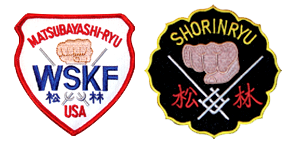Karate-Do

Karate originated in Okinawa from one of the basic instinct of man, the desire for self-preservation. It was taken from the ancient forms of "Te" which were the use of hands taught in Okinawa before the 17th and 18th centuries. This original form of karate took on some influences during the 18th century from a form of Chinese martial art called To-te.
It was in 1609 that the Satsuma clan of Japan banned weapons and the practice of martial arts on the Island of Okinawa. Since people had no weapons, they began to learn how to adapt simple working tools such as a long stick or rice cutting tools for their self-defense. The development of the art of Te also accelerated during this period of Okinawa's history. In fear of reprisal from the ruling Japanese government, the forbidden art of Te and the special uses of these simple Okinawan farming tools were secretly practiced and handed down from father to son through the generations. It was not until the late 17th and early 18th century, when karate began to take shape and merge with Chinese martial arts to that we are more familiar with today.
Because of the secrecy in which Te had to be practiced, there are no existing records indicating various styles or types of karate during the 18th century. Gradually karate divided into two main groups or types called Shorin-Ryu or Shuri-Te, and Shorei-Ryu or Naha-Te. Shorin-Ryu developed around the vicinity of Shuri Castle while Shorei-Ryu primarily was practiced around the city of Naha.
Matsubayashi is the Okinawan pronunciation of the characters for "Pine Forest." "Shorin" is the Chinese pronunciation of the same characters, and the origin of the name "Shorin-Ryu" is the Shaolin Buddhist Temple in China. "Ryu" roughly translates to style or system.
As Master Nagamine points out in his book, The Essence of Okinawan Karate-Do, the basic differences between Shorin-Ryu and Shorei-Ryu lay in the basic movements and method of breathing. Shorin-Ryu (Shuri-Te) stems from certain training forms linked to natural movements and breathing is controlled naturally during training. Shorei-Ryu (Naha-Te) is characterized by strong rooted movements and artificial breath control in accordance to each of the movements preformed. "Both styles share the common characteristic of observing only natural stances," states Master Nagamine. Naha-Te divided into two styles of karate -- Goju-Ryu and Uechi-Ryu. Shuri-Te divided into three styles - two are called Shorin-Ryu and the third is called Matsubayashi-Ryu. Matsubayashi-Ryu is the style we practice in the WSKF.
Still practiced in the strictest of secrecy during the 19th century, Shuri-Te and Naha-Te continued to develop and become unique forms of Okinawan karate. In 1875, the Satsuma clan ended the occupation of Okinawa, but it was not until 1904 when karate was first introduced into the Okinawan School System as a form of physical education, that karate started to be openly taught and practiced. In 1922, Gichin Funakoshi and Choki Motobu took Okinawan karate to Japan for the first time. This introduction of karate into mainland Japan marked the beginning of the spread of this martial art throughout the world.
At the time karate was introduced to Japan, this martial art was still referred to as To-Te (Chinese Hands) or karate (empty hands). In the 1930's, karatemen insisted there must be a consensus on what this art was to be called. At a 1936 meeting attended by renown Okinawa karate masters, it was agreed that the Okinawan art should be called karate, meaning "an empty-handed self-defense art," or "weaponless art of self-defense."
Karate survived the ravages of World War II and it was in 1947 that the public first hears of Matsubayashi-Ryu Karate-Do. This occurrence was when Master Shoshin Nagamine opened his first dojo (school) and named it "Matsubayashi-Ryu Kododan Karate and Ancient Martial Arts Studies." Matsubayashi is the Okinawan pronunciation of the characters for "Pine Forest." "Shorin" is the Chinese pronunciation of the same characters, and the origin of the name "Shorin-Ryu" is the Shaolin Buddhist Temple in China. "Ryu" roughly translates to style or system. Master Nagamine credits the name Matsubayashi out of respect for two great karate-ka's Bushi Matsumura and Kosaku Matsumora, who taught two of his most influential teachers - Chotoku Kyan and Choki Motobu.
In the years that followed it's opening, Master Nagamine's dojo grew in both notoriety and size. Soon American servicemen stationed in Okinawa began to train at his school. In 1959, the United States was first introduced to Matsubayashi-Ryu karate when James Wax, now an ex-serviceman and the first westerner to obtain a black belt, opened a school in Dayton, Ohio. Sensei Wax taught many renowned black belts during the 1960's, many of which went on to make significant contributions to the world of karate in the United States and around the world. One of Sensei Wax's top students was Frank Grant, known to us as Hanshi Grant. In 2007 during a weeklong celebration event honoring Hanshi Grant's 75 birthday and his many contributions to Matsubayashi-Ryu Karate-Do during his 50 years training and teaching, the WSKF Board of Directors awarded Hanshi Grant the rank of Ju-Dan, 10th degree Black Belt, the highest-ranking karate man in Matsubayashi-Ryu Karate-Do.
For additional information and detailed history of Okinawan Karate-Do and the founding of Matsubayashi-Ryu Karate-Do, it is highly recommended that all students read Grand Master Nagamine's book titled "The Essence of Okinawan Karate-Do." This best selling book is essential reading for any serious martial art student and is regarded as one of the absolute best books documenting karate. Students also should read Master Nagamine's second book called "Tales of Okinawa's Great Masters." This book is filled with tales and pictures and is for all martial artists whose karate originates from the Ryukyu Islands. It is a history of great Karate Masters of the past. Both of Master Nagamine's books are published by Tuttle Martial Arts.
